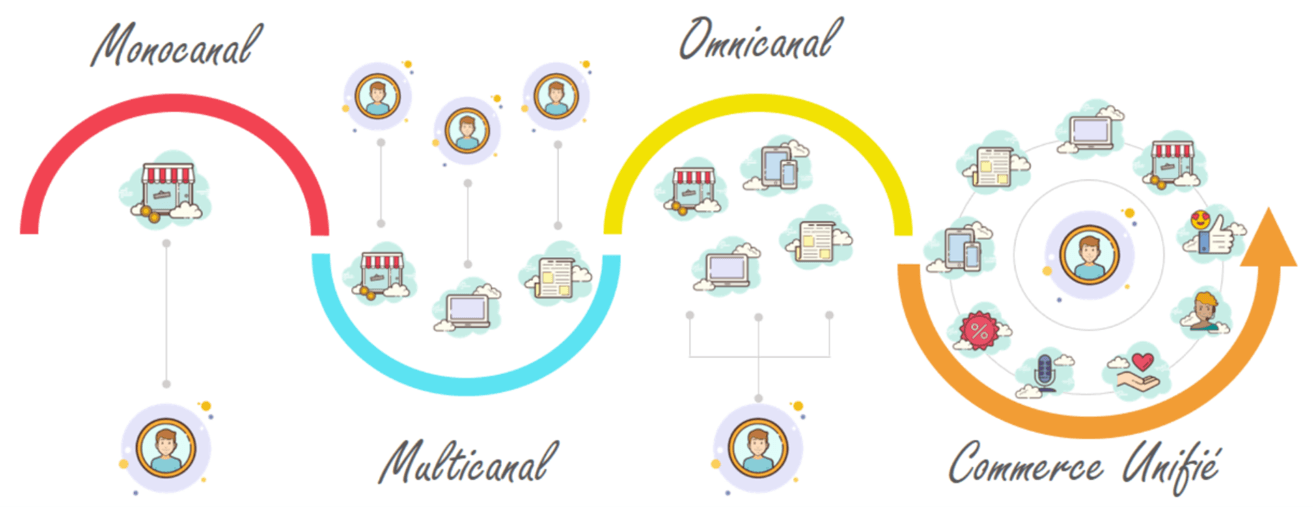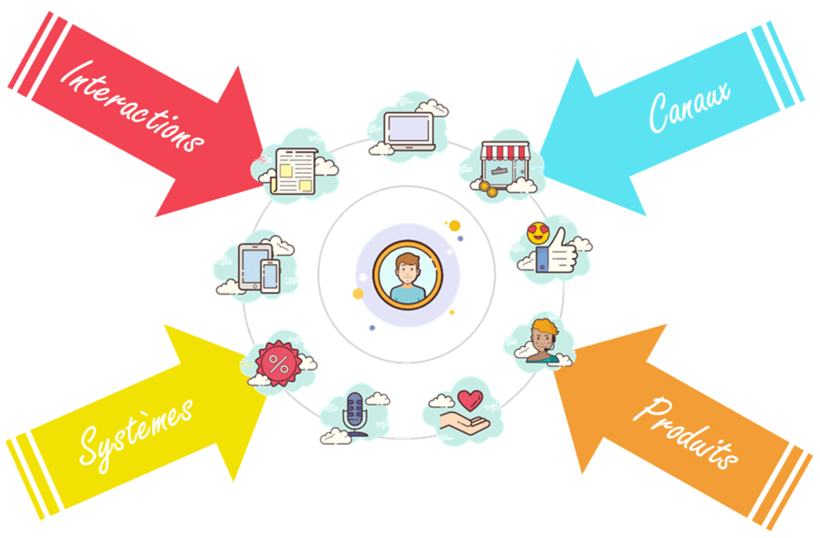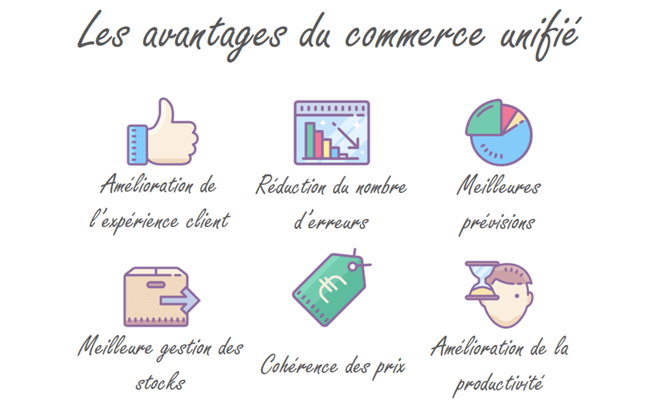A constantly evolving customer journey
The following diagram traces the evolution of the customer journey from single-channel to unified commerce, focusing on the sales channels involved.

Let's take a look at the various stages:
- The single-channel: lor a customer, single-channel commerce means using a single channel for the entire purchasing process (information, subscription or purchase, product life and after-sales service). This form of commerce implies having either only physical stores, or only an e-commerce platform (e.g. pure players or DNVB).
- Multi-channel: Multi-channel commerce refers to a customer's use of several purchasing channels. The customer then chooses the most appropriate, easy-to-access or familiar channel, depending on the purchasing stages they go through. The disadvantage of multi-channel commerce lies in the lack of communication between the two channels, and the frustrations that can result.
What are the limits of multi-channel commerce?
In the case of a multi-channel experience, a retailer may have an e-commerce site and stores, but these two channels are generally compartmentalized and communicate little with each other.
Let's take a representative example: siloed inventory management. Where stores and websites each have their own stock, items purchased in-store can often only be returned in-store, and online orders cannot be returned in-store.
Nevertheless, consumers are becoming less and less attuned to brands according to their distribution channels. So the customer journey must be seamless between each channel. As a customer, I want to be able to interact with the brand online, in-store, from my mobile or social networks in the same way.
The shift from multichannel to omnichannel represents a real paradigm shift. Omnichannel finally puts the customer at the center of its thinking.
Omnichannel: towards a seamless customer journey?
- Omnichannel: Omnichannel commerce means ensuring that all the customer's points of contact with the brand communicate, to guarantee the best possible experience.
For example, a customer who is used to buying on a brand's website and visits a store for the first time, is recognized and has a unique customer account, enabling him/her to accumulate loyalty points on in-store AND online purchases.
While an omnichannel strategy requires companies to invest in merging or communicating historically independent systems, it also enables retailers to reduce operating costs by pooling them across all distribution channels.
But then, how can unified commerce be the next step in commerce, if omnichannel already focuses on the customer, and unifies the customer journey?
Unified commerce, an improved omnichannel strategy?
- Unified commerce: Unified commerce is designed to ensure that systems communicate and data flows freely. Rather than simply connecting the different systems used, as omnichannel does, a unified commerce strategy relies on a centralized commerce platform to provide consistent, accurate information across all organizational channels.
As you've probably guessed by now, setting up a unified commerce platform means drastically simplifying a company's Information System (IS). Instead of connecting different systems, we rethink and simplify the whole by creating a single database shared by the whole company.
This platform must include several essential components:

- Interactions - this involves recording the behavior of users or consumers on the different channels, so that we can communicate with them more fluidly.
For example, I record all newsletters sent to a customer, whether from a physical store, a website or a mobile application, to avoid an unpleasant influx of similar communications for the customer.
- Channels - thismeans ensuring that when a customer switches to a different channel, the experience remains seamless. Consistency is key. For example, my customer finds the same promotions in store, online or via a mobile app.
- The systems - it's allabout ensuring that systems are consistent with each other. Whether it's a sales management application, a checkout solution, e-commerce platforms or a customer data management solution, each is important for specific business functions and as part of a wider ecosystem.
- Products - this involves ensuring that product information is accurate andup-to-date.
For example, if a product is out of stock in a store, the customer immediately sees it on the website and can choose another store or make an online purchase.
Implementing such an IS implies such organizational changes that it is legitimate to question the competitive advantage of setting up a unified commerce platform?
Here are just a few examples of the benefits of implementing unified commerce:

- Improved customer experience : if the company has a single database, the customer has unified information, making for a smoother experience. When you consider that 86% of consumers are willing to pay more for a better customer experience (source: Vision Critical), the math is pretty simple.
- Fewer errors : having a single database means fewer errors linked to disparate data sources.
- Better forecasts : 360° data enable much more accurate predictive analysis than would be possible by reconciling scattered data.
- Improved inventory management: cross-channel inventory visibility not only reduces inventory costs and unnecessary logistics expenses, but also facilitates the customer returns process.
- Harmonized pricing : similar prices across different channels limit customer frustration and ensure customer confidence.
- Business process automation: improving employee productivity is made possible by centralizing data and reducing time-consuming manual tasks. Employees can then concentrate on revenue-generating activities.
After reading this article, you want to set up a unified commerce platform: Univers Retail can help you every step of the way. Discover our expertise and let's talk > find out more about our expertise.

